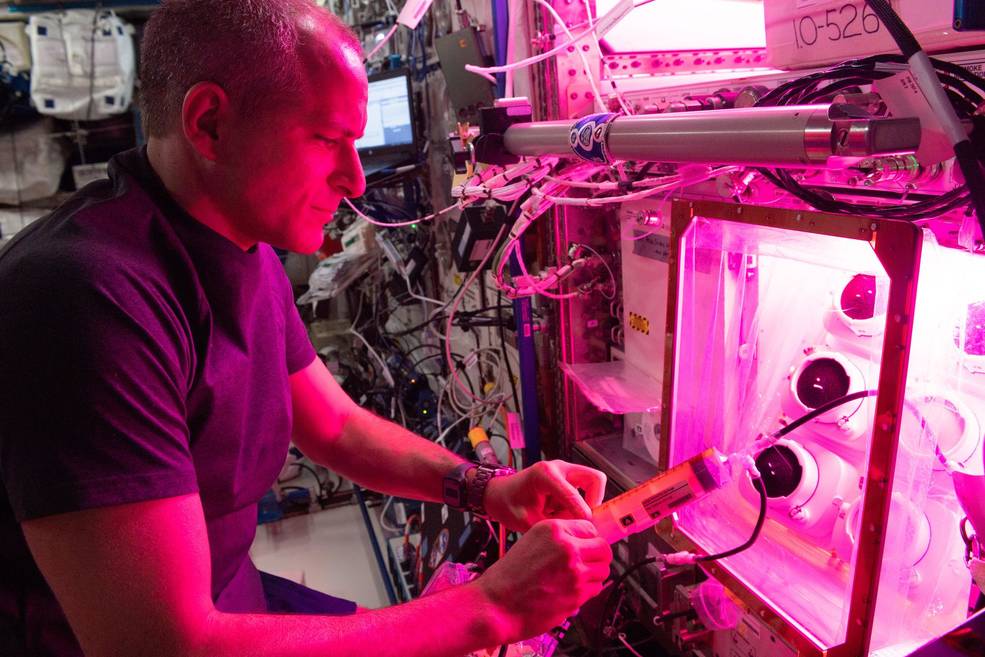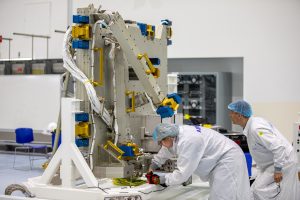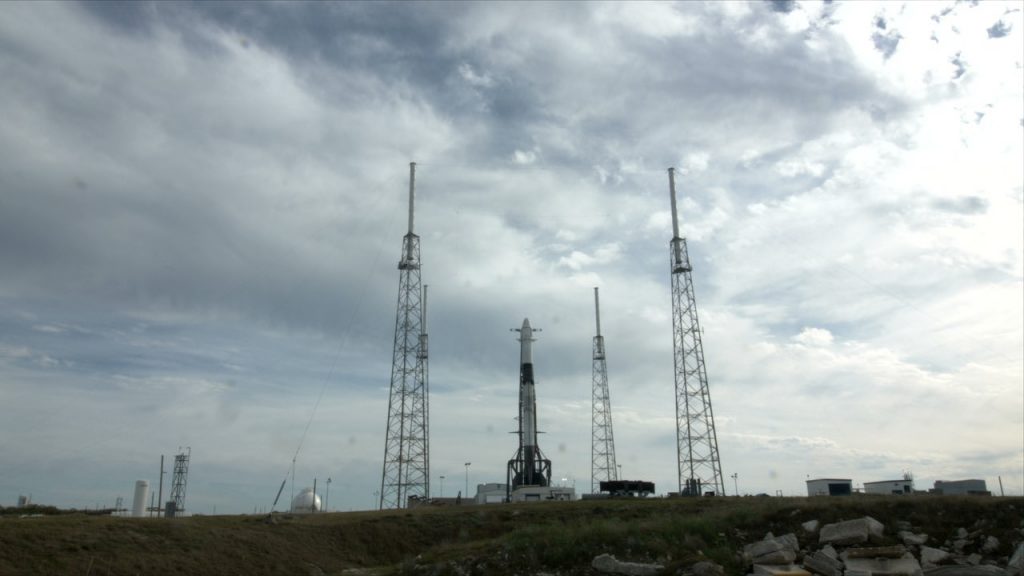The Dragon spacecraft has separated from the second stage of the SpaceX Falcon 9 rocket.
First Stage Main Engine Cutoff; Second Stage Burn Begins
The Falcon 9 rocket’s first-stage engines have finished their burn and the first stage has separated from the vehicle. As the second stage continues the flight, the first stage will aim for a landing at Cape Canaveral Air Force Station.
Liftoff! SpaceX CRS-20 Mission is Underway

T-0, ignition and liftoff of the SpaceX Falcon 9 rocket and Dragon spacecraft at 11:50 p.m. EST, setting off on the company’s 20th mission to deliver supplies, equipment and science experiments to the International Space Station. The vehicle is quickly climbing away from Space Launch Complex 40 at Cape Canaveral Air Force Station in Florida.
Ten Minutes Until Launch of SpaceX CRS-20 Mission

The countdown continues toward liftoff at 11:50 p.m. EST, an instantaneous window, 10 minutes from now. During this time, the Falcon 9’s engines will be chilled to condition them for launch, the flight computer will run its prelaunch checks and the rocket’s propellant tanks will be brought to flight pressure. Finally, the SpaceX Launch Director will verify “go for launch.”
About three minutes prior to launch, the gantry-like strongback support structure will be lowered away from the rocket. The terminal countdown begins at T-30 seconds.
SpaceX Falcon 9 Set to Launch Dragon Spacecraft to the International Space Station

Hello and good evening from NASA’s Kennedy Space Center in Florida. A SpaceX Falcon 9 rocket and Dragon spacecraft stand ready for liftoff, at Space Launch Complex 40 at Cape Canaveral Air Force Station. Launch is targeted for 11:50 p.m. EST, with an instantaneous launch window.
The Falcon 9 rocket went vertical this afternoon. Weather is 60 percent favorable at launch time. Dragon’s internal countdown is running and propellant loading is underway.
This evening’s launch is a cross-country effort. Launch controllers at the Florida spaceport are working in concert with teams at NASA’s Johnson Space Center in Houston and SpaceX’s control center in Hawthorne, California. The launch blog originates from the NASA News Center here at Kennedy, a few miles west of the launch complex. There’s more to come, so stay with us.
SpaceX CRS-20 – What’s On Board


During SpaceX’s 20th Commercial Resupply Services Mission to the International Space Station for NASA, the Dragon cargo spacecraft will deliver about 4,500 pounds of supplies, equipment and numerous science investigations to the crew aboard the station. Among the science experiments are:
- Bartolomeo, a new commercial research platform from the European Space Agency, set to be installed on the exterior of the orbiting laboratory.
- Gut-on-Chip is an experiment that could provide a better understanding of how microgravity and other potential space travel stressors affect intestine immune cells and susceptibility to infection, which could protect astronaut health on future long-duration missions. It also could help identify the mechanisms that underlie development of intestinal diseases and possible targets for therapies to treat them on Earth.
- Advanced Combustion via Microgravity Experiments (ACME) project is a series of six independent studies of gaseous flames that will be conducted in the Combustion Integrated Rack onboard the orbiting laboratory.
- Aboard the space station, NASA will use the Japan Aerospace Exploration Agency’s Electrostatic Levitation Furnace (ELF) for two new experiments: Thermophysical Property Measurement investigation will study small spheres of metal to provide a better understanding of how to measure liquid metal properties; and the Origin of Fragility in High-Temperature Oxide Liquids experiment will investigate what happens when high temperatures are applied to those same small spheres of various metal oxides.
- The Advanced Colloids Experiment Temperature-2 (ACE-T-2) experiment will look at the complex structures of these micron-scale colloidal particles, and how they assemble in microgravity conditions. Using the electron microscope on board the International Space Station, scientists will observe these particle interactions when different temperatures are applied to them.
-

The Biological Research in Canisters – Light-Emitting Diode (BRIC-LED) facility powers six BRIC-LED canisters for the Biological Research In Canisters-Light Emitting Diode-002 (BRIC-LED-002) investigation. Image courtesy of Sarah Swanson and Simon Gilroy. Biological Research in Canisters-Light Emitting Diode-002 (BRIC-LED)-002 investigation will test whether spaceflight affects the ability of plants to defend themselves against pathogens. Research on plant function in microgravity also contributes to a better understanding of basic plant processes, which could support development of better agricultural practices on Earth.
- VEG-PONDS-03 will evaluate how plants, in this case lettuce, grow in a newly developed plant growth system known as PONDS, or Passive Orbital Nutrient Delivery System. The PONDS units have features that are designed to bypass the lack of gravity in order to distribute water. They also are able to increase the plant’s oxygen exchange and provide sufficient room for root growth. VEG-PONDS-03 is a direct follow-on to the VEG-PONDS-01 and VEG-PONDS-02 hardware and plant growth validation tests.
Research investigations sponsored by the U.S. National Laboratory include:
- adidas Boost in Space seeks to investigate the flow of nonuniform foam particles to study the mixing and packing behavior in the absence of gravity. Results will help inform manufacturing process of Adidas Boost shoe soles, which contain polymer particles fused together.
- Capillary-Driven Microfluidics in Space is a project that aims to perform capillary-driven microfluidics experiments in space. Experiments will include capillary filling of microstructures, particle focusing and plasma separation, and microfluidic flow in thermal gradients.
- Spherical Cool Diffusion Flames Burning Gaseous Fuels will seek to increase a fundamental understanding of the physics of cool diffusion flames by observing quasi-steady spherical flames on porous burners in microgravity. Although cool diffusion had been observed in earlier drop tower experiments, cool flames had never been observed as steady spherical flames because drop tower experiments had uneven burn rates.
- Droplet Formation Studies in Microgravity will seek to evaluate the water droplet formation, water flow, and pressure of Delta Faucet’s current H2Okinetic show head technology versus the industry-standard use of jet nozzles. H2Okinetic technology allows better control of droplet size and increases the speed of the drops, which creates a feeling of increased pressure for the end user.
SpaceX CRS-20 Mission Timeline

COUNTDOWN (all times approximate)
Hour/Min/Sec Events
– 00:38:00 SpaceX Launch Director verifies go for propellant load
– 00:35:00 RP-1 (rocket grade kerosene) loading begins
– 00:35:00 1st stage LOX (liquid oxygen) loading begins
– 00:16:00 2nd stage LOX loading begins
– 00:07:58 Dragon transitions to internal power
– 00:07:00 Falcon 9 begins pre-launch engine chill
– 00:01:00 Command flight computer to begin final prelaunch checks
– 00:01:00 Propellant tanks pressurize for flight
– 00:00:45 SpaceX Launch Director verifies go for launch
– 00:00:03 Engine controller commands engine ignition sequence to start
– 00:00:00 Falcon 9 liftoff
LAUNCH AND DRAGON DEPLOYMENT
Hour/Min/Sec Events
– 00:01:18 Max Q (moment of peak mechanical stress on the rocket)
– 00:02:18 1st stage main engine cutoff (MECO)
– 00:02:22 1st and 2nd stages separate
– 00:02:29 2nd stage engine starts
– 00:02:35 1st stage boostback burn begins
– 00:06:32 1st stage entry burn begins
– 00:08:17 1st stage landing
– 00:08:35 2nd stage engine cutoff (SECO)
– 00:09:35 Dragon separates from 2nd stage
– 00:12:02 Dragon’s solar arrays deploy
– 02:19:00 Dragon’s Guidance, Navigation and Control bay door opens
Learn more about station activities by following @space_station and @ISS_Research on Twitter as well as the ISS Facebook and ISS Instagram accounts.
SpaceX Falcon 9 and Dragon Cargo Spacecraft Poised for Launch

The rocket awaiting launch late this evening is the SpaceX Falcon 9, a two-stage vehicle topped by the company’s uncrewed cargo Dragon spacecraft. This will be the Falcon 9 rocket’s second flight. It previously flew on CRS-19 in December 2019. It is the Dragon cargo spacecraft’s third trip to space, having flown previously in support of CRS-10 and CRS-16 missions. The Falcon 9 first stage is powered by nine Merlin engines that ignite at T-0. Its second stage has a single Merlin engine that takes over after separation of the first stage. Merlin engines, also built by SpaceX, run on a combination of cryogenic liquid oxygen and a refined kerosene fuel called RP-1.
Installed atop the rocket, the Dragon cargo spacecraft will deliver about 4,500 pounds of science investigations and cargo to the International Space Station. The Dragon offers a pressurized section as well as an unpressurized “trunk” section for additional cargo. Also located in the trunk are the spacecraft’s power-producing solar arrays, which will open shortly after Dragon arrives in orbit.
This is SpaceX’s 20th and final contract resupply mission under the first Commercial Resupply Services contract with NASA. It is also the last SpaceX CRS mission to use the Dragon 1 vehicle. Future missions under the CRS-2 contract will utilize the Dragon 2 spacecraft and will return to Earth with a water landing in the Atlantic Ocean.
Read more about the Falcon 9 rocket and the Dragon spacecraft.
Launch Day Arrives for SpaceX CRS-20

Liftoff of a SpaceX Falcon 9 rocket and Dragon cargo spacecraft is targeted for 11:50 p.m. EST this evening. Countdown activities are in progress at Space Launch Complex 40 at Cape Canaveral Air Force Station in Florida, where the rocket awaits launch on the company’s 20th commercial resupply mission to the International Space Station.
CRS-20 is the second U.S. resupply mission to the space station this year, and the first resupply mission for SpaceX this year.
Be sure to join us here on the blog and on NASA Television beginning at 11:30 p.m. EST for updates from the countdown. Learn more about the SpaceX CRS-20 mission by going to the mission home page at http://www.nasa.gov/spacex.
SpaceX CRS-20 Prelaunch News Conference
 A prelaunch news conference for SpaceX’s 20th Commercial Resupply Services mission for NASA to the International Space Station is set for 4 p.m. EST today.
A prelaunch news conference for SpaceX’s 20th Commercial Resupply Services mission for NASA to the International Space Station is set for 4 p.m. EST today.
Participants include:
- Joel Montalbano, manager for International Space Station Program
- Jennifer Buchli, deputy chief scientist for International Space Station Program
- Hans Koenigsmann, vice president, Build and Flight Reliability at SpaceX
- Mike McAleenan, launch weather officer, 45th Space Wing, U.S. Air Force
Watch the news conference on NASA Television.
NASA commercial cargo provider SpaceX is targeting 11:50 p.m. EST tonight, March 6, for the launch of resupply mission to the space station.
Follow the launch countdown tonight beginning at 11:30 p.m. on NASA TV and the launch blog. To learn more about the SpaceX CRS-20 mission, visit the mission homepage at http://www.nasa.gov/spacex.
